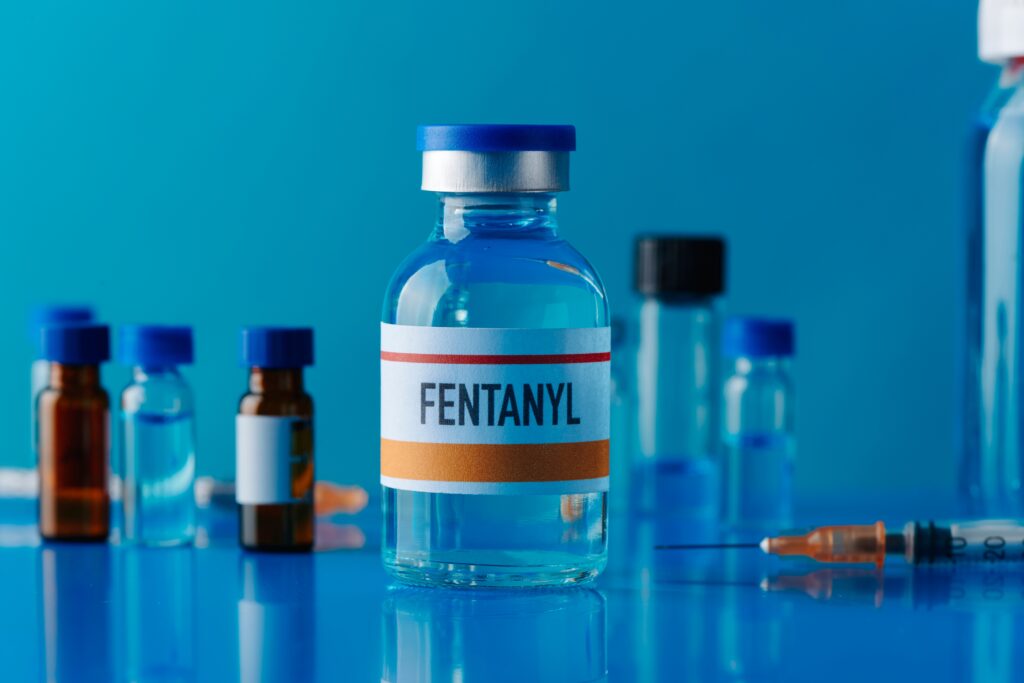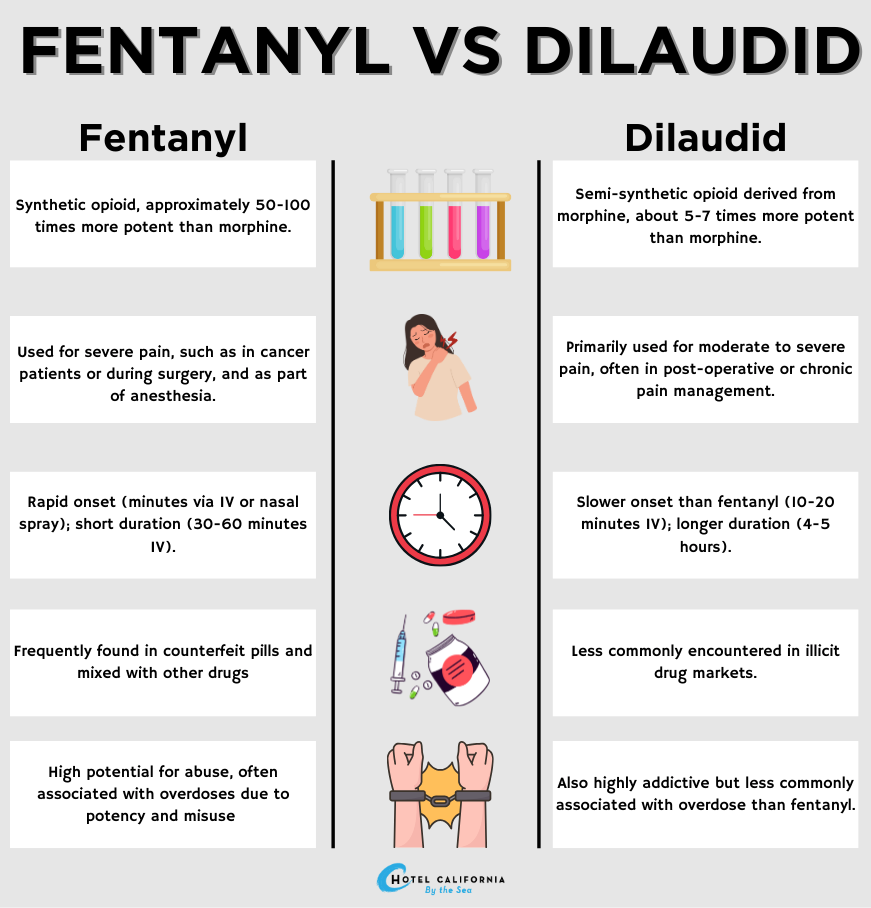Fentanyl vs Dilaudid
Fentanyl and Dilaudid are both powerful pain-relieving opioid substances. Schedule II controlled substances are used to treat various types of acute and chronic pain. Both substances have also contributed to the 16 million people worldwide, who struggle with opioid use disorder. This includes more than 3 million Americans. In a 2022 report, over 1.5 million prescriptions for Dilaudid were issued to more than 500,000 Americans. It was one of the most frequently prescribed opioids in the US. On the other hand, fentanyl has become one of the most dangerous drugs in the US. Its high potency, low cost, and ease of manufacture make it one of the most commonly found illicit compounds causing the opioid overdose epidemic.

The popularity of street fentanyl has dramatically increased since 2013 and it is the main driver of the opioid public health crisis in the US. It is more common to find illicitly manufactured and sold fentanyl cut with other substances such as heroin and cocaine. In 2021, an estimated 70,601 overdose deaths were linked to synthetic opioids such as fentanyl. Dilaudid is a potent opioid, though not as powerful as fentanyl, and has increasingly been found on the street market. An estimated 1.62 million Americans reported using substances such as Dilaudid, with an estimated 190,000 people misusing the opioid.
Both drugs are opioids and produce pain-relieving properties. Both drugs can also lead to the development of opioid use disorder. Common signs of opioid use disorder include a strong desire to take opioids, needing to take a higher dose to achieve the same effects, disruption of daily life due to taking opioids and experiencing withdrawal symptoms when opioid use has abruptly decreased or stopped.
Fentanyl vs Dilaudid
Both fentanyl and Dilaudid are opioid narcotic pain relieves. They work by activating the mu-opioid receptors in the brain that block the pain signals, increase the threshold to pain, reduce the perception of pain and produce feelings of euphoria. Both controlled substances are available in prescription form as well as sold illicitly on the black market. Mental and physical dependence and addiction can occur even when the substances are medically prescribed and taken as per the recommendation of a medical provider. However, when these substances are used outside of the parameters of prescription medication, they pose a higher risk for deadly outcomes. The abrupt cessation of either drug after long-term use can lead to precipitated withdrawal causing nausea, diarrhea, coughing, nasal discharge, profuse sweating, muscle twitching and yawning.
Both drugs can cause respiratory depression and have a high risk of overdose. However, because fentanyl is more powerful, there is a much higher risk of overdose because even the smallest amount can suppress breathing. Fentanyl tends to metabolize faster so the onset of effectiveness and pain relief is quicker. The opioid has a faster onset of action. But this also means the effects do not last as long. The duration of effects in Dilaudid lasts much longer because of its slower onset of effects.

Fentanyl
- Fentanyl is 50 times more potent than heroin and 100 times more potent than morphine
- Street fentanyl is a fully synthetic opioid substance
- Fentanyl is often added or cut with other drugs to enhance or intensify the effects of the other substance
- It is a prescription medication and is also sold illicitly on the street market
- Fentanyl is available in the following formulations – injection, patch, lozenges, dissolving tablet, sublingual tablet, sublingual spray and nasal spray
- Illicitly manufactured street fentanyl is sold either as a powder or tablet and is oftentimes made to resemble the look of other prescription medications
- Prescription fentanyl is approved as anesthesia before or during recovery from surgery, long-term severe pain management or treatment of pain related to cancer
- Fentanyl is often prescribed when other pain relief treatments do not work and is usually approved for people who are already taking opioids or are opioid-tolerant
- Common side effects – nausea, vomiting, fatigue, insomnia, sweating, decreased appetite, headache, slowed breathing, dry mouth, abdominal pain, confusion, nervousness, depression, stiffness and slowed heart rate
- Prescription fentanyl is most commonly used in a hospital or clinical setting only
- Fentanyl is so potent, that it requires smaller doses
- The cost of fentanyl is typically around $50-64 per gram
- 2 cartons or 5 patches of fentanyl is around $31.96
Dilaudid
- Dilaudid is the brand name for the generic medication hydromorphone
- Dilaudid is a semi-synthetic opioid pain medication derived from morphine
- Dilaudid is 2-8 times more potent than morphine and has been used in the US since the 1920s.
- Dilaudid is available in the following formulations – tablets, capsules, liquid solutions, injections and suppositories
- Dilaudid is often prescribed to treat moderate to severe pain after surgery, to manage quick or sudden pain and to treat chronic pain
- Common side effects – dizziness, sedation, nausea, vomiting, sweating, euphoria, dry mouth, itchiness, constipation, stomach pains, respiratory depression and constipation
- Dilaudid can be used in a clinical or home setting
- Dilaudid needs to be tapered off in order to avoid uncomfortable withdrawal symptoms
- 30 tablets of 2mg cost around $7.11
- The average cost of Dilaudid ranges between $5-100 per mg
Check Your Insurance Coverage for FREE
Find out if your insurance covers addiction treatment in minutes. We accept most insurance!
Dangers of Fentanyl and Dilaudid
- There is a potential for misuse and addiction
- Respiratory depression
- Opioid overdose
- Difficulty concentrating
- Extreme fatigue and sedation
- Physical dependence
- Withdrawal symptoms
- Serotonin syndrome
- Low blood pressure and heart rate
- Low adrenal hormone levels
- Seizures
Reach out to Hotel California by the Sea
We specialize in treating addiction and other co-occurring disorders, such as PTSD. Our Admissions specialists are available to walk you through the best options for treating your addiction.
Treatment for Opioid Use Disorder
Fentanyl and Dilaudid are powerful opioid medications that are prescribed to treat acute pain, moderate to severe pain and chronic pain. Research has found that fentanyl can be a more effective choice for pain relief in those who are already addicted to opioids. It is even more effective than morphine because it causes fewer side effects. Despite Dilaudid being a controlled substance and an opioid pain reliever, it is much less potent than fentanyl. However, the medication works quickly with the maximum level of the medication in the blood within 30 minutes to an hour after being orally ingested. Both medications can also lead to tolerance, dependence and the development of addiction. Professional behavioral health programs such as Hotel California by the Sea offer rigorous treatment for opioid use disorders.
We offer treatment at all levels of care including detox, residential, partial hospitalization program and intensive outpatient program. Our program also provides evidence-based treatment methods including cognitive behavioral therapy, dialectical behavioral therapy and family therapy. Hotel California by the Sea is dedicated to helping clients reach their goals in recovery and overcome their addiction.
References:
https://www.verywellhealth.com/fentanyl-vs-dilaudid-8643920
https://www.bicyclehealth.com/opioid-education/fentanyl/vs-dilaudid
https://anrclinic.com/blog/dilaudid-vs-fentanyl/
https://www.goodrx.com/compare/dilaudid-vs-fentanyl
https://www.medicinenet.com/dilaudid_vs_fentanyl/drug-vs.htm#what_are_the_side_effects_of_dilaudid_vs_fentanyl
